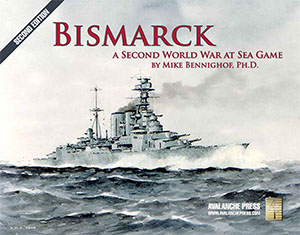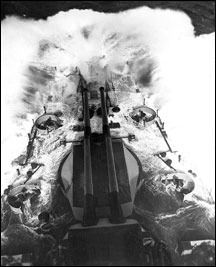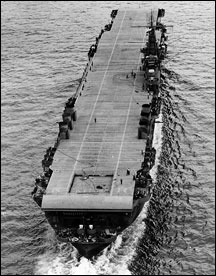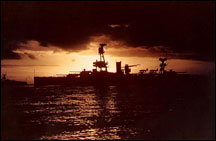| Americans
and the Bismarck
By Mike Bennighof, Ph.D.
January 2022
 It upsets some of our British friends when
American entertainment media insert American
heroes where they weren’t present. But
in one of the Royal Navy’s finest achievements
of World War II, the U.S. Navy and Coast Guard
were definitely present and doing their best
to stretch “neutrality” past the
breaking point. It upsets some of our British friends when
American entertainment media insert American
heroes where they weren’t present. But
in one of the Royal Navy’s finest achievements
of World War II, the U.S. Navy and Coast Guard
were definitely present and doing their best
to stretch “neutrality” past the
breaking point.
President Franklin D. Roosevelt correctly
saw Adolf Hitler and his Nazi regime as a
grave threat to civilization. In the fall
of 1940, Roosevelt ordered 50 elderly destroyers
given to the Royal Navy in exchange for basing
rights in various British colonies. In March
1941 came the Lend-Lease Act, which provided
huge quantities of military equipment to Britain.
But getting those goods and plus supplies
of food and fuel across the Atlantic required
naval escort.
On 7 April 1941, the U.S. Navy took bold
steps to intervene in the war zone. Neutrality
patrols had been undertaken along the Eastern
Seaboard starting in September 1939, but these
had not gone very far out to sea. On the 7th,
the U.S. Navy took formal possession of its
new base at Bermuda and based a carrier task
force built around Ranger there. These
forces had instructions to patrol the “Western
Hemisphere,” and on the 18th that definition
was stretched out to 30 Degrees West longitude
— about halfway across the North Atlantic,
almost to Iceland or the Azores. In addition
to the forces stationed at Bermuda, starting
on 5 May American battleships based at Portland,
Maine, and stopping at Argentia, Newfoundland,
for refueling probed into the Atlantic south
of Iceland — well past the new line
of demarcation.

Even battleships have a hard time in
the North Atlantic. USS New York pounds through heavy seas.
|
Also on 7 April, reinforcements were ordered
dispatched from the Pacific Fleet. Over the
next six weeks the carrier Yorktown,
battleships New Mexico, Idaho and Mississippi, four cruisers and 18 destroyers departed
Pearl Harbor and San Diego. And from the U.S.
East Coast, a carrier task force built around Wasp moved to Bermuda on 15 May.
These forces would “mark” German
raiders if they located them: provide scouting
reports to the Royal Navy and, if possible,
shadow the German ships. Just how far their
captains’ verbal orders went is disputed
today, but if the Americans were not looking
for a fight, they were certainly not going
to back away from one, either.
While the Royal Navy had a substantial edge
over the Germans in fighting power, at least
on paper, there were some other factors that
Roosevelt hoped to mitigate with this assistance.
First, the North Atlantic is very large. With
bases in Norway and France, the Germans had
several routes to infiltrate raiders into
this large open body of water. Once through
the “choke points” between Greenland
and Iceland or between Iceland and Scotland,
a German cruiser coming from Norway could
disappear fairly easily. Once away from the
Bay of Biscay, one based in France also had
a great gray vastness before her.

Neutral air cover: the carrier Ranger.
|
Second, the Royal Navy was fairly old and
the North Atlantic is very rough. Germany’s
raiders had been laid down in the 1930s; most
of the British battleships expected to destroy
them had been laid down in the years before
World War One. Hard service wears on a warship,
especially when it’s called on to steam
at high speeds through rough water. Out of
every three battleships or battle cruisers
the Royal Navy had available on paper, at
least one of them would be in dockyard hands
at any particular moment as leaks were patched
and worn-out machinery repaired.
The American probes deep into the Atlantic
to “enforce neutrality” would
help mitigate this somewhat. By September
1941, American battleships would be stationed
in Iceland with orders to find and fight the
German battleship Tirpitz should she
attempt to burst into the Atlantic. But when
Bismarck made her famous raid in May 1941,
American intentions were not yet so explicit.
Near the southern exit of the Denmark Straits
(the stretch of water between Greenland and
Iceland), the Coast Guard cutter Modoc encountered Bismarck on 24 May as the German battleship
steamed quickly past after having destroyed
the battle cruiser Hood. Modoc challenged
and received no reply. Shortly afterward,
eight Swordfish torpedo planes from
the carrier Victorious located Modoc,
circled her, and then veered off straight
to Bismarck to make an unsuccessful
torpedo attack.
Did Modoc provide target data to
the British planes? The cutter’s log
does not say, the British account merely mentions
that the planes spotted Modoc. Given
that the planes circled Modoc and then
headed directly for their target, it seems
very likely that the Americans stretched their
neutrality.

USS Texas in the North Atlantic,
summer 1941.
|
About 300 miles to the southeast,
the battleship Texas and three destroyers
had completed their neutrality patrol and
exercises well east of the “Western
Hemisphere” demarcation line and would
soon turn back. Heading out of Norfolk, Virginia,
her sister ship New York and three
destroyers were on their way to relieve her.
Both had orders to report any German warship
to the Royal Navy. However, the Atlantic Fleet’s
third battleship, Arkansas, was undergoing
a refit and not available to keep a battleship
constantly on station south of Iceland. Texas,
on her way back to Newport, Rhode Island,
crossed Bismarck’s southerly
track a day or two before the German battleship
entered the Atlantic. The New York task
group only reached its patrol zone after the
action had moved on, but almost blundered
into Bismarck’s consort, the
heavy cruiser Prinz Eugen.
Had either American battleship encountered Bismarck, it’s impossible 67
years later to predict how their commanders
would have reacted. A surprise sighting at
night would likely have caused the Germans
to open fire immediately. On paper, the American
battleships did not match up to Bismarck.
The two American ships displaced 27,000 tons
each against 42,000 for Bismarck. They
matched up well in primary armament but were
not nearly as well protected — the German
battleship would prove that she could absorb enormous
punishment. New York never faced that
sort of damage, though she survived the atomic
bomb tests at Bikini Atoll after the war.
She would not have been likely to sink Bismarck, but could probably have made sure she
never reached home. Excellent crew quality
and short range would give the American battleship
a slight chance to cripple the much more modern Bismarck: despite their elderly equipment,
the gun crews of Texas and New York actually achieved a higher rate of fire
than did their counterparts on the German
“super” battleship. And the loss
of an American battleship in a surface action
with a German warship could easily have brought
American public opinion around to supporting
war with Germany.
In Second
World War at Sea: Bismarck, both American
battleship task forces are present
as well as the cutter Modoc. The Allied
player may use them to search for German warships
(and tankers) but under a number of restrictions
on initiating combat. The Central Atlantic
Neutrality Patrol carrier task groups are
there, too.
The two American battleship task groups were
present on the battlefield, and so they are
an integral part of the game.
You can order Bismarck Second Edition right here.
Sign up for our newsletter right here. Your info will never be sold or transferred; we'll just use it to update you on new games and new offers.
Mike Bennighof is president of Avalanche Press and holds a doctorate in history from Emory University. A Fulbright Scholar and NASA Journalist in Space finalist, he has published a great many books, games and articles on historical subjects; people are saying that some of them are actually good.
He lives in Birmingham, Alabama with his wife, three children, and his Iron Dog, Leopold.
Want to keep Daily Content free of third-party ads? You can send us some love (and cash) through this link right here.
|
